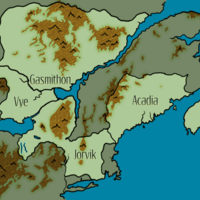Ingredients
Though a certain pallette of ingredients is common across the Land, their preparation varies wildly. This list is not exhaustive, but does account for foods available with any degree of regularity and reliability. Things vary by season and how productive the year has been.
- Corn, rye, and ubeans form the staple crops. They compliment each other nicely in terms of crop rotation, so fields need to be left fallow less often than in the past.
- Next in popularity come onions, potatoes, sunchokes, gourds, pumpkins, cabbage, and carrots.
- Nearly all housholds keep an herb garden of basil, bergamont, sage, parsley, cilantro, and mint. In additiont to cooking, these are used for preparing tea.
- Orchards grow apples, pears, grapes, and peaches. Berries are mostly harvested from the wild.
- Gardens and farms are full of tomatoes, greens, hot chiles, and peas.
- Acadia enjoys a near-monopoly on salt production. Oil is primarily derived from ubeans, though sunflower, pumpkin, or flax seed oil is also popular.
- More honey is gathered in the south - more tree syrup in the north. Grape molasses is used in some regions.
- Though ubeans provide the bulk of most household's protein, eggs, feastworms, and confit are welcome additions to the table.
- Animal milk is rare as an ingredient - most of it is reserved for the production of cheese, which stores and trades better. Ubean milk is very common, though.
- When cuts of meat are desired, they are generally fish, chicken, rabbit, or trollizard tail. Mutton is a rare treat, and beef is out of the reach of most of the populace.
- Only the very rich are able to include wheat, Xichaltan coffee, chocolate, or vanilla in their diets with any regularity.
